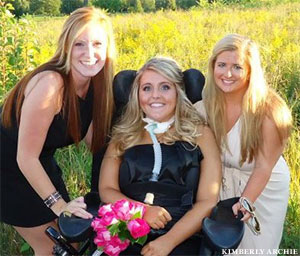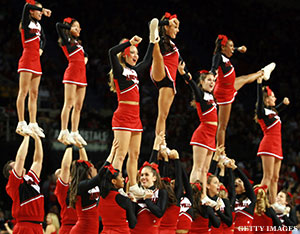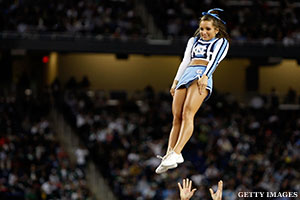
You cannot identify with Laura Jackson.
You can feel bad for her, mourn her situation, but you cannot -- unless you too are paralyzed from the neck down – fathom her pain. Unless someone brushes your teeth, takes you to the bathroom and hand-feeds you every meal, there is no understanding how Laura Jackson feels.
Locked in her chair, tubes in her throat, she can only dream of those cold Michigan winters when she and her sisters learned how to ice skate so they would have an excuse to leave the house. That hard pain of falling on cold ice over and over, now a memory distant enough to belong to someone else.
There is another pain she remembers. She was 14, trying out for the varsity cheerleading squad. She knew that the varsity girls could all do back handsprings, so in her private tumbling classes a few weeks before, Jackson learned a back tuck. As she warmed up in her high school gym, she decided to give it a try.
Another girl, just 16 years old, came over to spot her. Jackson stood up straight, body tense, then uncoiled. As she fell backward, she lost her balance. The spotter, unsure of what to do, didn't move. Jackson's head cracked so violently against the floor that a piece of her scalp ripped off, and she lay there, gasping for breath that didn’t come.
The ambulance arrived before they could find someone who knew CPR. In the days to follow, Jackson learned that her last steps were behind her. Her C1 and C2 vertebrae were broken and the bones were clamping down on her brain stem, causing her heart to stop. She would spend seven months in the hospital, but there was no cure for what ailed her. She would never walk again.
"Life is a struggle," Jackson says, "and I guess I've been put in a wheelchair for a reason."
She pauses.
"Maybe."
The injuries read like the workers' comp filings at a construction site: Brain contusions, broken bones, blunt force trauma. Somewhere along the line, a massive rift has opened up between perception and reality -- between the Dallas Cowboys cheerleaders and the girls who fell 20 feet and never got up again.
When it comes to sports injuries, football is, and always has been, king. No other sport comes close. Over the past 28 years, football players were the victims of 97 percent of all catastrophic sports injuries -- accidents that result in permanent or temporary paralysis or death. But when the National Center for Catastrophic Injury Research Center released its 28th annual report last year, the numbers for cheerleading were staggering.

"It's been at crisis level," says Dr. Frederick O. Mueller, one of the paper’s authors. "Football's always a concern. Cheerleading's number two."
Cheerleaders incur two-thirds of all catastrophic injuries to female athletes in high school and college. As cheerleading’s popularity soared over the last 20 years, so have the number of cheerleaders in the hospital. According to the National Electronic Injury Surveillance Survey, emergency room visits increased 110 percent from 1990 to 2002. In 2007 alone, almost 27,000 cheerleaders ended up in the ER, one in six for head or neck injuries.
If the public finds these numbers hard to believe, cheerleaders don't.
"They think that we're waving pom-poms around and kicking in the air," says Jackson, whose speaking voice is still normal, if a bit halting, after her accident. "But we're throwing another human being 30 feet in the air and trusting three other teenagers to catch you."
The sweet American stereotype -- beautiful young women in white uniforms shaking pom-poms -- has been replaced by a much more brutal brand of cheerleading. An internet search of "All-Star cheerleading" illustrates its new incarnation: Girls being thrust sky-high, landing hard on the hands of their teammates tasked to catch them.
Cheerleading is no longer the stuff of Sandra Dee -- it has become an athletic event.
"I hear way too often from girls ... that they feel like they're getting blown off," says Dr. David Geier, the director of sports medicine at the Medical University of South Carolina. " 'Cheerleading? How could anyone get hurt in cheerleading?' They feel like nobody takes them seriously."
In 2005, 14-year-old Ashley Burns was struck in the torso by her teammates' arms as she fell from a stunt, lacerating her spleen. She died before her mother arrived at the hospital. Three years later, 20-year-old Lauren Chang was killed after being accidentally kicked in the chest by another cheerleader. There’s the story of a male cheerleader who was paralyzed while tumbling, the young woman who will now likely spend the rest of her life in a nursing home after falling while cheering for Marshall High in Los Angeles, and the girl who plunged to her death from a human pyramid.
Only a few weeks ago, Michigan State cheerleader Taylor Young fell face-first onto the court at a Spartans basketball game and needed a neck brace. She was taken to the hospital and doctors released her later the same night.
Since her daughter was injured while cheerleading near Los Angeles, Kimberly Archie has investigated every death, every case of paralysis. In 2008, she made cheer safety her occupation by founding the National Cheer Safety Foundation.
Archie is especially frenetic this week because five catastrophic injury reports are sitting on her desk. She rarely gets this many at once -- she used to receive them via an online submission form on the NCSF website, but Archie claims coaches have clamped down on that practice for fear that it was making their sport appear disproportionately dangerous. Now, she's well-known enough that she gets them directly from attorneys representing injured cheerleaders.
"The girl shattered her foot and the coach laughed at her, and no one even called an ambulance," Archie relates as she flips through a report. "Her teammates actually picked her up and put her in the car and drove her to the hospital. Now she's had two surgeries and has been in a wheelchair for a year."
Today, perhaps no major physical activity in America is as unevenly regulated as cheerleading. In a quirk of bureaucracy, the Office of Civil Rights determines what is and what is not a sport. And, for the last 30 or so years, they've staunchly defended their position that cheerleading is not a sport in an effort to prevent schools from using preexisting cheer squads to pad Title IX numbers.
Because the Office of Civil Rights doesn’t recognize cheerleading as a sport, no organization possesses the right to mandate change. And, even if individual states tried to, no policing force exists.
"It still amazes me that this happened to me, and that this is still is happening,” says Jackson. "Because it seems like such a stupid mistake on the part of the schools, it not being considered a sport.
"You never think going into football practice that there’s not going to be any regulations."
In the absence of a governing structure, cheerleading operates more like an industry than a sport. That multi-million dollar business starts and ends with one man.

After graduating from Oklahoma in the early 1970s, former cheerleader Jeff Webb founded the Universal Cheerleaders Association, the first of many companies that now falls under the jurisdiction of Varsity Brands. Varsity Brands is ubiquitous in the cheerleading world. From pom-poms to uniforms to shoes, DVDs to T-shirts, the Memphis-based company manufactures, promotes and sells just about everything related to the cheer. Their name-brand familiarity is no accident -- it's the product of years of Webb’s relentless efforts to control the market.
As soon as Webb took over the company, he set about vastly expanding Varsity’s empire. Perhaps his biggest initiative was to introduce something cheerleading lacked: competition.
Because cheerleading did not fall under the umbrella of the NCAA or state high school federations, no large scale competitions existed. Cheerleaders performed in a vacuum, looking pretty with no payoff.
To garner national attention, Webb promoted his own brand of cheerleading competitions across the nation. When you think of cheerleading competitions, you no doubt think of his -- Webb guaranteed that by inking massive deals with ESPN to ensure that, even in those first formative years in the 1980s, Varsity’s competitions would be the ones looking professional, fun and well-attended on television.
There's also no question that these events were created as money-making tie-ins to Varsity. After Webb testified as an expert on cheerleading in a Title IX case, the judge stated that Webb “never imagined that his competitions would establish a new sport; rather, he understood his competitions as a publicity vehicle for his startup business."
To qualify for their competitions, cheerleaders must attend Varsity summer camps, which cost hundreds of dollars, and pay entry fees. Once inside the gates, squads score extra points for using Varsity's uniforms, pom-poms, shoes and more. It's shameless, but it doesn't profess to be anything other than what it is -- a business venture for a for-profit company.
What started out as a publicity vehicle soon turned into a sleek, expensive bullet train. Webb's summer camps distinguished themselves from his competitors through more daring and exciting gymnastics maneuvers. When the squads meet in his competitions, the wildest, most crowd-pleasing routines take home the trophies.
Over the years, Webb has also distinguished between sideline cheer-- the sort we imagine NFL cheerleaders doing -- and competitive cheer, the one that involves pyramids and tosses. Sideline cheer, he has testified both in court and out of it, is not a sport.
The problem is that the line between competitive and sideline isn't so clear anymore. Go to any local high school football game and you'll likely see 15-year-old girls throwing each other in the air, with or without mats to cushion a fall. Cheerleading has evolved from a relatively passive sideline activity to a physically daring sport. The safety regulations haven’t.

"They had to up the ante by adding all these crazy gymnastics to it and lying to everybody and calling it cheerleading," Archie says. "Because that’s what it is: It’s gymnastics on a scary surface with untrained coaches."
Legal action brought by injured cheerleaders has been surprisingly scarce. Varsity Brand's nonprofit safety branch, the AACCA, was named in a wrongful death lawsuit filed by Ruth Burns, mother of Ashley Burns, who died in an cheerleading accident in Massachusetts in 2005. However, the judge dismissed the case and no financial compensation was awarded to the Burns family.
"By the time I got there, it had escalated into this really competitive program, and yet we still had the same moms and college-aged kids teaching," Jackson says. "We were doing things gymnasts were learning to do. The level of training never met with the rise of the competitiveness."
Only 13 states require cheerleading coaches to be certified, but the certification process became another controversial creature. The nonprofit which provides certification, the American Association of Cheerleading Coaches and Administrators, is a subsidiary of Varsity Brands. The AACCA safety course is available online and the test is open book. The exam is reminiscent of a driving permit test, except that no practical, behind-the-wheel element ever follows.
For critics of Webb and Varsity Brands, the AACCA cannot be separated from its entrepreneurial parent company. It’s hard to deny that from a business standpoint, Varsity Brands benefits from minimal regulation. More stringent safety standards would mean that its practice of putting on massive summer cheer camps would be severely tested. The 350,000 cheerleaders who participate in their camps annually would need mats at a minimum and, many would argue, indoor facilities equipped for tumbling.
In a lengthy email containing many examples of advances in cheerleading safety, Sheila Noone of Varsity Brands wrote:
"It is our strong belief that even one injury is one injury too many, and as an organization we have taken steps to ensure that cheerleading remains a safe and enjoyable activity for all participants. We are driven to create the safest possible environment for all cheerleaders. The same regulations would create an even more acute problem for schools. One of the allures of cheerleading is that it requires almost no equipment. Schools provide little beyond uniforms and shoes. Adding safety regulations would likely mean that some schools would cut cheerleading altogether."
The quiet crisis in cheerleading stands in marked contrast to the well-publicized upheaval over safety that football has experienced the last decade. As evidence mounts that brain trauma can lead to a lifelong host of health problems, football has re-opened the rule book. In March, the NFL pinpointed kickoffs as the single most dangerous play, so kickoffs were moved up to the 35-yard line to increase the number of touchbacks. During the season, Eagles quarterback Michael Vick made headlines by wearing a Kevlar-lined helmet to protect him from further concussions.
No such massive, sweeping change has yet touched cheerleading.
“You can’t build a playground on grass in this country because scientists have proven that grass is not soft to fall on,” Archie says. “You can’t load a bomb in a war zone above six feet if you’re not tethered.
"But you can throw a cheerleader as high as you want at a high school football game, and nobody cares."

When you ask a cheerleader if she is afraid of falling, you always get that pause as she looks into the void and sees her worst nightmares staring back at her. Then, she shakes it off and puts on a smile.
Tatiana Powers has been cheerleading just one year but, like any other high school athlete, it consumes her. Right now, the sophomore from Northern California trains four days a week for a season that lasts from May until March. She does weight training, strength and conditioning, and stunting.
And every Friday night, she lets her friends lift her up on their hands and toss her up toward the stadium lights.
Krista Parks and Brittney Noffke used to do the same thing. They were small, lithe, pretty girls who could fly. Then one day, Parks plunged 20 feet directly on the top of her head while cheering at the University of Memphis. Noffke was dropped onto the tile floor of a cafeteria at her Wisconsin high school attempting a new stunt upon her coach’s recommendation.
Both girls suffered severe brain trauma and the accompanying mood swings, depression and memory loss that went with it. Their lives for months, then years, were uncertain and lonely.

But life has gone on for them, as it has for Laura Jackson. After she was released from the hospital, Jackson returned to high school and, incredibly, graduated on time. She’s currently pursuing a degree at Madonna University, thanks in large part to the constant assistance from her sisters, and she still hopes that someday her life once again will involve cheerleading -- this time as a coach.
"Not that I'm going to be busting out any cheer moves for them," Jackson says, able to laugh, "but I would be coaching them on."
Jackson knows there is much work to be done. The safest high school programs use spotters, but, unless parents want to pony up for professionals, they’re generally just teammates. Is it ideal to have a 16-year-old responsible for the life of another 16-year-old? And who wants to live with the guilt of letting a friend fall?
"I was just cheering for a football game, hanging out with all my friends, going to classes," Parks says. "It was shock from all that, because when you're 21 you don’t ever have you think you’ll have to deal with something like that."
Cheerleading suffers from a unique perception problem. Many people detest cheerleaders. Their role on the sideline has been sexualized and stigmatized, and in the myth of the cheerleader, we've lost sight of what the sport has become -- a high-level skill set that isn’t required to follow rules that govern any other sport.
So, each time we hear about another girl splitting her skull open on a wooden gym floor, it's easier to blame the individual than face a problem endemic to the system.
"When word got out that I had gotten injured, the first thing the school did was shut down the stunting aspect of cheerleading and competing," Noffke says. "A lot of people didn’t bother to even see if I was OK. They just blamed me."
Says Parks: "I lived it. All the people I thought were my friends, they turned their backs on me so quick."
Luckily, the vast majority of cheerleaders will never have to experience what Parks, Noffke and Jackson endured. Like Tatiana Powers, they'll have four happy years in high school accumulating the usual scrapes and strains of an athlete. They'll make friends, and they'll move on. Most will never have to see how fragile they are when they fall.
Their darkest moments will only happen in their imagination.
"It definitely does cross my mind, but for the team, I do try to push through it." Powers says, her voice uncertain at first before steadying. "I trust who my teammates are.
"I trust that they’ll catch me."




